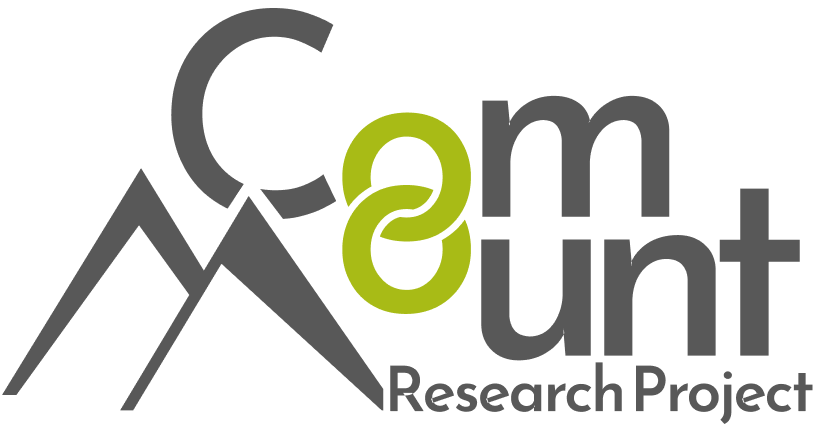Mountain COMmons : questioning past and present Commons to address territorial development issues in MOUNTain areas (ComMount) is a Swiss National Science Foundation (SNSF) funded project conducted at the University of Lausanne, in collaboration with Università della Svizzera italiana (USI) and CREPA (Centre Régional d’Etudes des Populations Alpines), from 2023 to 2027.
The project is lead by Prof. Leïla Kebir, with Prof. Emmanuel Reynard, Prof. Stéphane Nahrath and Prof. Luigi Lorenzetti as co-applicants. Yann Decorzant and Roberto Leggero are Project Partners. Nona Nenovska is a Post-doctoral Researcher, Diego Graziola and Loïc Giaccone are PhD Students. You can find more details on the team here.
You will find a summary of the project in French here and Italian here.
Scientific abstract:
In the context of global change, mountains are facing important economic, social and environmental issues. Among the various possible levers to respond and adapt to these challenges, contemporary forms of collective action – that we name ‘new mountain commons’ – appear as potential lever for addressing these issues.
Commons are defined here as a specific pattern of relationships between three components of a social-ecological configuration, which are (1) a resource (orography, rivers, know-how, cultural heritage, history, infrastructure, etc.) understood here as a complex system; (2) a community (a set of actors such as owners, appropriators, users, etc.) sharing a common objective and (3) a set of rules regulating the relationship between the actors regarding the access, use and management of the resource system. More specifically, commons correspond to a collective action developed by the users of the resource (i.e. the ‘commoners’) characterised by self-organisation allowing implementing a sustainable management of the resource (system) (Ostrom 1990). In this research we focus on commons located in mountain areas. More specifically, we focus on new mountain commons, that is commons that were recently created (end of 20th-beginning of 21st century). Following Hess (2008) new commons are characterised by the fact that they appear “without pre-existing rules or clear institutional arrangements“ (Hess, 2008). As such they differ from traditional commons that have existed for a long time with formal or informal structures, often recognised by the State. They concern the provision of goods and services coming from resources other than the ‘classical’ natural resources first observed by Ostrom (1990), i.e. forests, irrigation water, grazing lands and fisheries.
During a nine-month seed-funding project (University of Lausanne), our research team has identified and characterised ‘new mountain commons’ dealing with infrastructure such as ski lifts or energy production, heritage (community projects for architecture renovation of bread oven, watermills, pastoral hamlets, etc.), and the supply of local services (community groceries, cafes, maternity centre, etc.). The diversity of examples found in France, Switzerland and Italy shows that collective actions in the Alps are underway and address issues such as climate change, tourism transition, lowland-upland relationships, or social, cultural and economic development.
These preliminary observations lead us to further ask how these ‘new commons’ structure and organise and how they relate to the ‘historical commons’ that still remain in mountain regions. Furthermore, we question the spatial, social, political and economic conditions by which they emerge and develop and their role as a lever for territorial development and governance evolution. To address these issues, we will proceed in 4 work packages. First, we will create a common interdisciplinary research protocol and consolidate the choice of case studies (WP1). Next, we will conduct in-depth interdisciplinary case studies in two alpine regions (WP2). This will allow us to understand the role of new commons as a lever for territorial development and territorial governance evolution; it will also allow us to analyse the relationship with historical commons and development trajectories (WP3). Throughout the project we will develop integration and dissemination activities to foster debate and collect feedback from scholars and stakeholders (WP4).
As a result, we expect (i) to develop cutting-edge knowledge on new commons in mountain areas as well as on their contribution to the territorial development of mountain regions (ii) to identify relations (continuity versus discontinuity processes) between traditional and new commons, (iii) to identify good practices for and obstacles to the development of such commons.
Hess, C. (2008). Mapping the New Commons. https://doi.org/10.2139/ssrn.1356835
Ostrom, E. (1990). Governing the Commons : The Evolution of Institutions for Collective Action. Cambridge University Press. https://doi.org/10.1017/CBO9781316423936
